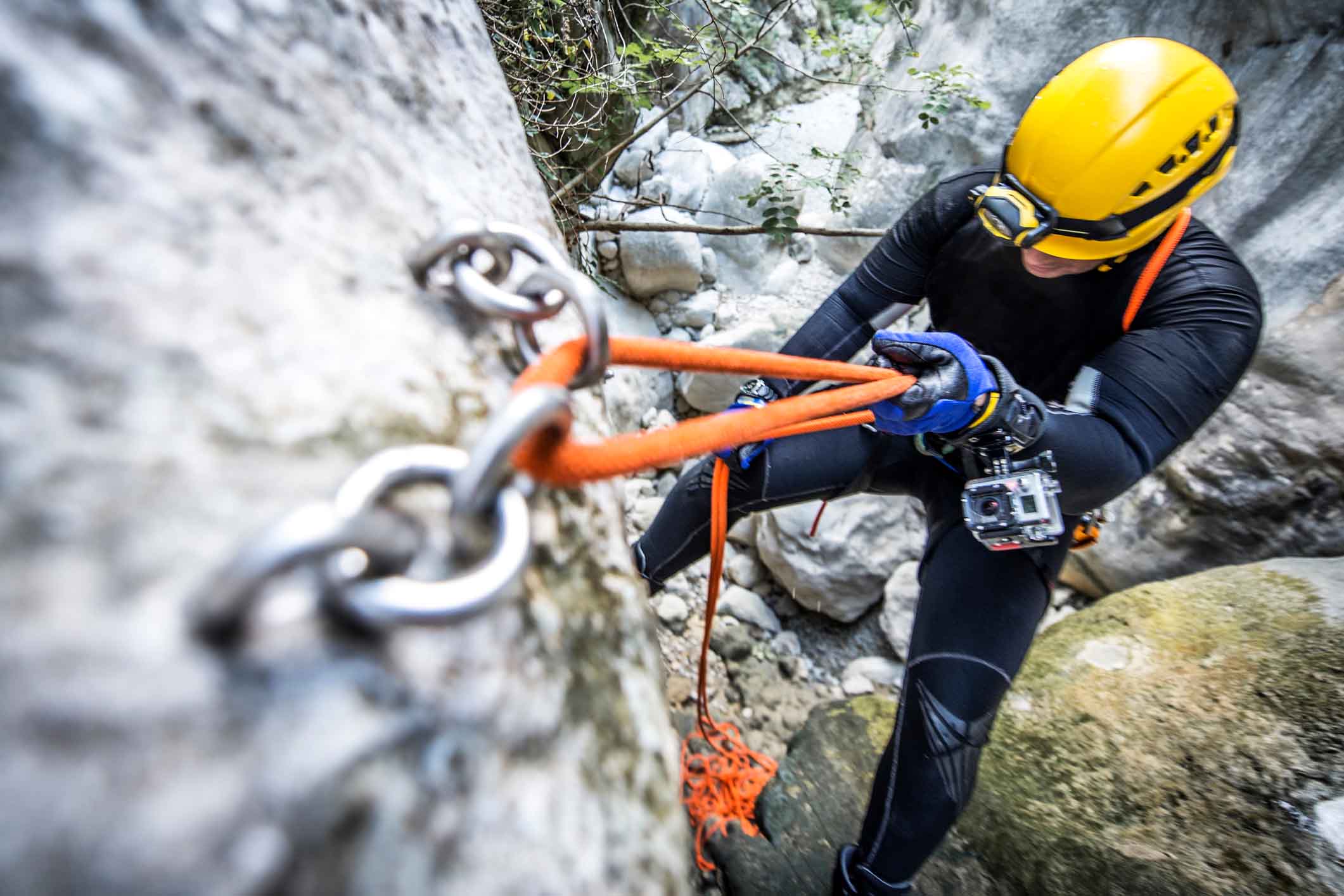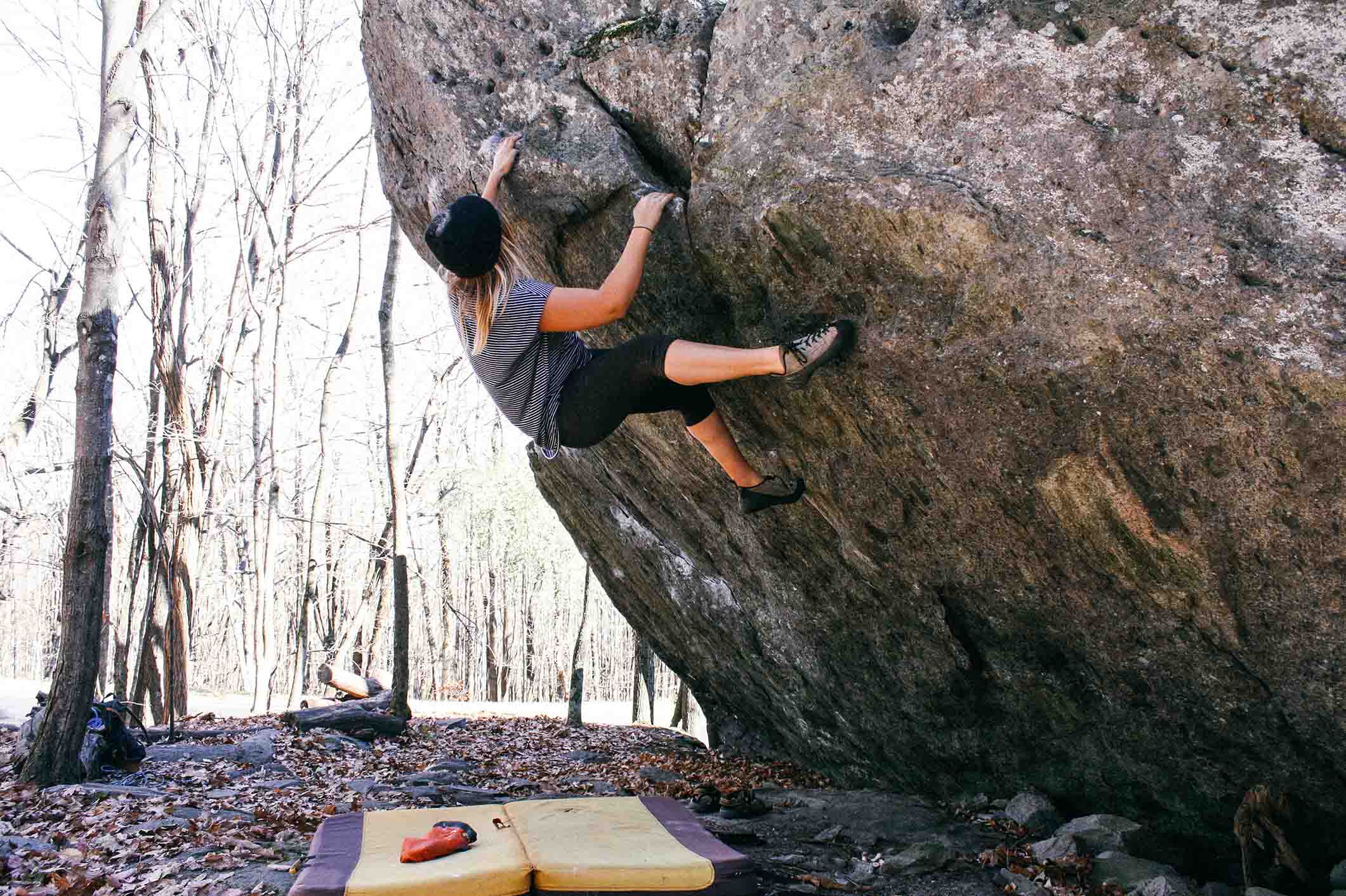What are the different types of rock climbing?
Rock climbing in the UK and abroad offers a wide variety of experiences, from bouldering on sea cliffs to traditional climbing on rugged mountains. Whether you’re a beginner or an experienced climber, there’s a type of rock climbing that suits your skills and preferences.
Remember to always prioritise safety. Proper training, equipment, and knowledge of the climbing area are essential in rock climbing. Additionally, check local access restrictions and conservation guidelines to ensure a positive climbing experience for yourself and to protect the environment.
If you’re wondering how many types of climbing activities there are to enjoy, find out in our full guide to rock climbing.

Aid climbing
Aid climbing involves using certain types of rock climbing equipment and gear to progress up a route, giving you the required level of support for that terrain. This technique is used when the natural features of the rock are insufficient for free climbing (climbing without relying on any gear). Aid climbing is often used when the terrain is mainly too difficult, blank (lacking holds or features), or overhanging to be free climbed. A certain amount of free climbing might still be necessary to reach the next placement, but the emphasis is on aid techniques.
As this is one of the more difficult types of rock for climbing, with a heavier reliance on tools, aid climbing is generally slower and more methodical than free climbing. You have to carefully evaluate each placement, clip in, and move upward. This style of climbing often requires strong problem-solving skills and route finding. Safety and proper gear usage are paramount in aid climbing, due to the risk of gear failure.
Aid climbers place protection devices, such as pitons, camming devices, nuts, and bolts, in cracks, holes, or other suitable features of the rock to create anchor points and protect against potential falls. These placements are often used for body-weight support and upward progression. Other equipment used to facilitate your ascent includes aiders (short ladders or slings and etriers (webbing ladders).
Aid routes are graded using the A0 to A5 system. A0 indicates the easiest form of aid climbing, where gear placements are solid and require minimal effort. As the grade increases to A5, placements become unreliable, and the risk of gear pulling out or failing also increases. For this reason, A5 aid climbing is considered extremely dangerous.
Climbers who are interested in aid climbing usually have a solid foundation in traditional (free) climbing and experience with the specific techniques and equipment required. It often involves longer, multi-day adventures, so you have to be well prepared with food, water, and the right clothing for extended stays on the wall.
Roped free climbing
This category of rock climbing, which doesn’t have protective aids within the rock but relies on ropes, is classed as roped free climbing. It falls into three categories: trad climbing, sport climbing and top rope.
Trad climbing
Traditional (trad) climbing involves placing protection gear as you climb, rather than relying on pre-placed bolts. Demanding physical and mental strength, it’s considered more adventurous than aid climbing. The UK is famous for its trad climbing, with classic areas including the Peak District, North Wales, the Scottish Highlands, and the South West.
Sport climbing
Sport climbing is carried out on designated routes, on artificial or natural rock faces, with pre-placed bolts for protection. You use quick draws to attach your ropes as you climb, which is a great way to build technical skills and stamina. The UK boasts several sport climbing destinations, such as Portland in Dorset, Gower in South Wales, and the Lake District.
Top rope climbing
Top roping is an ideal way for beginners to start climbing. A rope is anchored at the top of a route so that the climber is secured as they climb. This anchor can consist of bolts, slings, or other secure attachments that the rope runs through. You’ll be connected to the rope via a harness and a belay device. A belayer manages the slack in the rope to keep it taut while you ascend. If you fall, the belayer can apply tension to the rope, preventing a significant descent.
Top roping is one of the main types of indoor rock climbing, so there are many climbing gyms across the UK that offer top-roping facilities. However, you can enjoy it outdoors too; look for climbing centres with dedicated top rope areas.
Unroped free climbing
This falls into two types of rock climbing: bouldering and free soloing.

Bouldering
Bouldering involves short, powerful climbs on large boulders or low rock faces. It necessitates a high level of technique and strength, with good problem-solving abilities. You can find bouldering spots all over the UK, in popular areas including the Peak District, North Wales, and the Scottish Highlands.
A more advanced version of bouldering is highballing. Not for the faint-hearted, it involves much higher climbs. Whereas bouldering walls are up to 15 feet in height, anything over this is classed as highballing.
Free soloing
Free soloing is a form of rock climbing where you ascend a route without the use of any protective equipment, such as ropes, harnesses, or safety gear. In free soloing, the climber relies solely on their hands and feet to protect themselves against falls, using their physical and mental abilities to complete the climb. This is an extremely high-risk and daring style of climbing, which is generally reserved for the most experienced and skilled enthusiasts.

Multi-pitch climbing
In multi-pitch climbing, you ascend a long route that’s too tall to be climbed in a single pitch. Breaking the route into multiple sections or pitches, you’re protected by anchors in each one. It’s a great way to explore mountainous terrain. Find multi-pitch climbing in the Lake District, Snowdonia, and the Scottish Highlands.
Deep water soloing (DWS)
In DWS, you’ll climb over water without ropes or harnesses, relying on the water to break your fall. It’s an exciting and unique form of climbing, often practised on sea cliffs and coastal areas. The UK coastline, especially in areas like Swanage and the Llyn Peninsula, is known for DWS opportunities.
What types of rock do people climb on in the UK and abroad?
Climbers often seek out specific types of rock, to experience the distinctive qualities and challenges they offer. In the UK or further afield, climbers are spoiled for choice with a diverse range of rock types, each offering their own challenges and thrills.
The different types of rock climbing we can enjoy here give something for climbers of all preferences. Whether you enjoy traditional climbing, sport climbing, bouldering, or deep water soloing, you have access to a rich diversity of climbing experiences. Each type of rock presents its own set of challenges and characteristics for climbers of all levels.
Then again, if you’re looking to head overseas, there are endless rock-climbing adventures to be had around the world as you broaden your travel experience.
Here are some of the main types of rock you can climb:
Limestone: Limestone is a popular rock type for climbing in the UK, known for its variety of features with sharp edges and abundant holds. Some of the well-known UK limestone climbing areas include the Peak District (e.g., Stoney Middleton, Raven Tor), the Yorkshire Dales (e.g., Malham Cove), and the Mendip Hills. Popular limestone climbing destinations abroad include Kalymnos in Greece, Yangshuo in China, and the El Chorro region in Spain.
Sandstone: Sandstone offers a unique texture, with a mixture of crimps, slopers, and cracks. Climbing on sandstone often requires delicate footwork. It’s a prevalent rock type in the UK, especially in southern England. Climbers can find prominent sandstone routes in areas like the Southern Sandstone in the Southeast (e.g., Harrison’s Rocks, High Rocks) and the Peak District (e.g., Stanage Edge, Burbage). Elsewhere, notable sandstone climbing areas include Red Rock in Nevada, USA, and the Grampians in Australia.
Granite: Granite is famous for its friction and durability. Climbers often encounter cracks and flakes, making it a favourite for traditional (trad) climbing. While not as common as other rock types in the UK, there are superb climbing opportunities here. The most famous granite climbing area is in the Scottish Highlands, around the Cairngorms, with both traditional and bouldering routes aplenty. Other well-known granite climbing areas include Yosemite in the USA, Chamonix in France, and the Cairngorms in Scotland.
Gritstone: Gritstone has a unique texture, with sloping holds, pebbles, and sharp edges. It’s a renowned rock type in the UK, with climbing mainly found in the Peak District (e.g., Stanage Edge, the Roaches, Froggatt Edge) and nearby areas.
Slate: Characterised by the sharp, often small holds and unique friction properties of the rock, slate climbing is highly popular in North Wales, due to the iconic quarries there. Areas like Llanberis Pass and Dinorwic Quarry offer a variety of routes, known for their technical nature.
Schist: Schist provides a unique blend of features, such as flakes, jugs, and slopers. Climbing on schist often involves traditional climbing, and it offers stunning mountain routes. This is the predominant rock type in some parts of Scotland, such as the Northwest Highlands. The Dolomites in Italy also offer particularly striking schist climbing.
Volcanic rock: Volcanic rock, such as andesite and basalt, usually comprises an array of features, showcasing the different types of holds in rock climbing. The Giant’s Causeway in Northern Ireland features basalt columns formed by ancient volcanic activity, with various unique routes on these natural hexagonal pillars. Smith Rock in Oregon, USA, is also a notable example of volcanic climbing terrain.
Gabbro: Gabbro is a coarse-grained, dark rock that offers excellent friction. Head to the Isle of Skye in Scotland to take on this challenging, rough terrain.
Quartzite: Quartzite has sharp crimps and solid features, which are both demanding and enjoyable. You’ll find a mix of trad and sport routes on this rock type. Certain parts of the Welsh mountains contain quartzite crags, making them well worth a visit. Little Cottonwood Canyon in Utah, USA, is also famous for its quartzite climbing.
Chalk: The chalk cliffs along the southern coast, particularly in areas like Dorset, offer breathtaking sea cliff climbing. Climbers tackle steep and exposed routes overlooking the ocean, which can also be enjoyed in Normandy, France.
Ice and mixed terrain: In ice climbing and mixed climbing, climbers traverse frozen waterfalls and ice-covered rock faces. Popular ice climbing destinations include Ouray in Colorado, USA, and Rjukan in Norway.
Get Rock Climbing Insurance with SportsCover Direct
Having the right protection is essential when it comes to indulging in high-octane activities such as rock climbing. After all, there’s a certain level of risk involved, which is all part of the excitement. However, you don’t want to be left out of pocket if something does happen; this is why taking out a reliable rock climbing insurance policy is essential.
SportsCover Direct’s Rock Climbing Insurance offers specialist cover for up to 7,000m. Choose from travel insurance to protect you in the event of unforeseen expenses while overseas, whether you’re rock climbing competitively or just for leisure. If your plans change through no fault of your own, or you’re suddenly hit with medical costs, this policy will lessen the financial impact. Alternatively, choose a bolt-on that supplements your existing insurance policy, if you have one with another provider. There’s also an option for sports accidents, giving you personal liability and income protection.
Get a personalised quote now and confirm your new insurance in minutes. If you’ve any questions at all, just get in touch with our team.